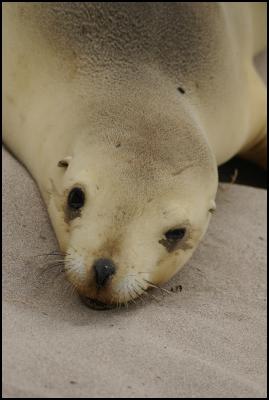Research reveals New Zealand sea lion is a relative newcomer

NZ Sea Lion. Photo: Louise Chilvers
Research reveals
New Zealand sea lion is a relative
newcomer
Embargoed until 11am Wednesday
14 May 2014
The modern New Zealand sea lion is a relative newcomer to our mainland, replacing a now-extinct, unique prehistoric New Zealand sea-lion that once lived here, according to a new study led by University of Otago researchers.
A team of biologists from the University of Otago estimates that this prehistoric mainland sea-lion population became extinct as recently as 600 years ago, and was then replaced by a lineage previously limited to the waters of the cold subantarctic.
The Marsden-funded study, carried out by Otago Zoology PhD student Catherine Collins, and led by Professor Jon Waters, set out to investigate changes in the New Zealand sea-lion population since human settlement.
Ms Collins says they were startled to identify a previously unknown sea-lion lineage that dominated South Island shores until just a few hundred years ago.
“It is
estimated that the mainland sea-lions became extinct between
1300 and
1500AD, soon after Polynesian settlement, and
midden remains suggest they were hunted extensively. The
extinction apparently created an opportunity for the
subantarctic lineage to colonise New Zealand’s mainland,"
she says.
The team identified the extinct mainland sea-lion lineage using ancient DNA from prehistoric bones.
“We found that the extinct mainland population was clearly genetically distinct from the modern subantarctic population that arrived more recently,” she says.
The unexpected finding closely mirrors a prehistoric extinction-replacement event for yellow-eyed penguins, recently detected by the same team led by Professor Waters.
“Our findings demonstrate that our current sea-lion population is not a declining remnant of an original mainland population, but rather represents a new arrival from the subantarctic,” he says.
“Competition between the two lineages may have previously prevented the subantarctic lineage from expanding northwards to the mainland of New Zealand."
Professor Waters adds that all they know for certain about the attributes of this prehistoric sea-lion is that it was genetically distinct from the modern sea-lion lineage. He anticipates that future study of the prehistoric remains will lead to a greater understanding of its biology.
The team’s findings have
been published today in the international
biological
research journal Proceedings of the Royal
Society B: Biological
Sciences.
ENDS


 Business Canterbury: Urges Council To Cut Costs, Not Ambition For City
Business Canterbury: Urges Council To Cut Costs, Not Ambition For City Wellington Airport: On Track For Net Zero Emissions By 2028
Wellington Airport: On Track For Net Zero Emissions By 2028 Landcare Research: ANZAC Gall Fly Release Promises Natural Solution To Weed Threat
Landcare Research: ANZAC Gall Fly Release Promises Natural Solution To Weed Threat NZ Anti-Vivisection Society: Auckland Rat Lovers Unite!
NZ Anti-Vivisection Society: Auckland Rat Lovers Unite! University of Canterbury: $1.35 Million Grant To Study Lion-like Jumping Spiders
University of Canterbury: $1.35 Million Grant To Study Lion-like Jumping Spiders Federated Farmers: Government Ends War On Farming
Federated Farmers: Government Ends War On Farming



